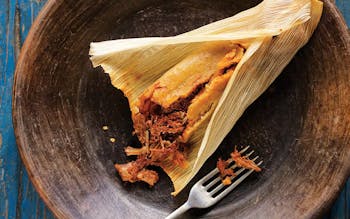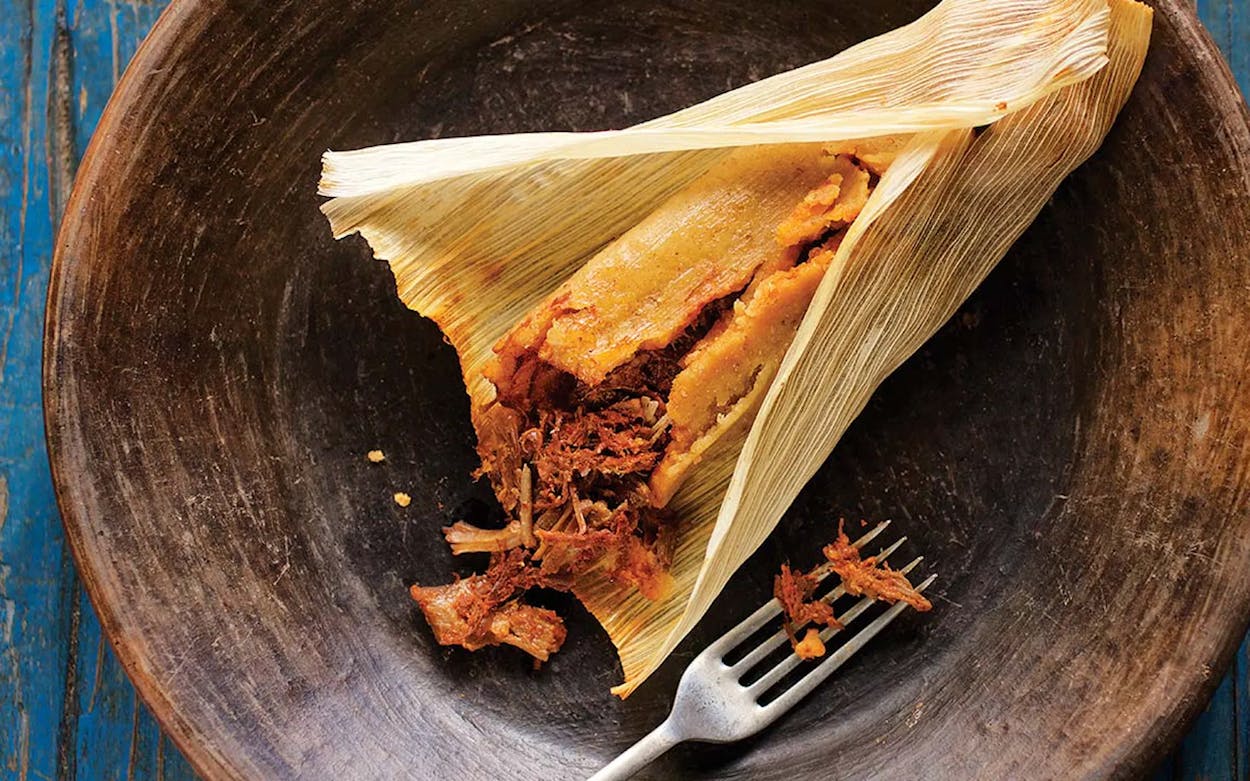It took me a while to shuck off my fear of making tamales. In my four years of Vittling, I’ve tackled a lot of foods Texans love to eat (if not necessarily cook), from corn dogs and barbecued crabs to gumbo and mole poblano. And I’ve done almost all of it in my tiny “two butt” kitchen, as my grandmother Elsie would have called it (which in this case is generous, because technically it holds only mine and that of my always-underfoot dog). But I’ve long been intimidated by the tremendous effort required to prepare those husky hunks of goodie-filled masa.
Turns out there was a reason for that, the same reason that tamales are typically a special-occasion food, served during celebrations and holidays, and the same reason they’re often assembled amid the convivial chaos of an all-hands-on-deck tamalada: they’re exhausting. After at least a dozen hours of chile-prepping, husk-cleaning, meat-shredding, and dough-spreading, not to mention the resulting mountain of dirty dishes, a porcine sheen on every surface, and masa in every nook and cranny beyond reach of the dog, I had myself a measly twenty tamales. Which were so fluffy, fragrant, and delicious I’ve decided to make them again—in a year or so, in someone else’s kitchen.

Pork Tamales
Equipment
- 1 electric mixer
- 1 Steamer basket
Ingredients
Corn Husks
- 1 package dried corn husks
Pork
- 1½ pounds pork butt, shoulder (trimmed and cut into large cubes)
- ½ white onion (peeled)
- 2 cloves garlic (peeled)
- 2 tsp kosher salt
- ¼ tsp coarse-ground black pepper
Chile Paste
- 3 ancho chiles (stems and seeds removed)
- 3 guajillo chiles (stems and seeds removed)
- 1½ tbsp lard (or your preferred fat)
- 3 cloves garlic (peeled)
- 1 tsp kosher salt
- ½ tsp ground cumin
- ¼ tsp black pepper
Masa
- ½ cup slightly chilled lard
- 1 tsp baking powder
- 1 pound coarse-ground masa for tamales (the already-prepared dough, usually in a 5-pound bag, found in Mexican markets; can also use dried masa harina, which you’ll need to prepare following the directions on the package)
- broth reserved from the pork butt (cooled and skimmed of fat)
- salt to taste
Directions
Husks
- Place a big handful of husks in a large bowl and cover with hot water; use a plate or heavy object to keep them submerged for about an hour.
Pork
- Put the pork, onion, garlic, salt, and pepper in a large pot and cover with water. Bring to a boil, then simmer for 1½ hours, periodically skimming and discarding the foam that rises to the top.
- Allow to cool, then shred the meat with your fingers or two forks back-to-back. Set the meat aside, and strain and reserve the broth.
Chile Paste
- In a heavy skillet, fry the chiles in ½ tablespoon of the lard until fragrant, about 30 seconds (can also dry-roast them on a cast-iron comal).
- Place the chiles in a bowl, cover with boiling water (about 2 cups), and let them soak for 15 to 20 minutes.
- Add the chiles to a blender along with 1 cup of the soaking liquid, the garlic, salt, cumin, and pepper and blend (adding additional liquid a little at a time if necessary) to make a fine paste.
- Melt 1 tablespoon lard in a heavy skillet and fry the paste (watch out for splatter) for a minute or so, until it turns dark and fragrant. Add around ¾ cup of the remaining chile liquid and simmer, for about 15 minutes, till thick and glossy.
- Add ¼ cup of the chile paste to the pork (more or less depending on how much meat you’ve ended up with and your desired ratio). Add salt if needed.
- Reserve a bit of the remaining chile paste for the masa, if desired. (If you’re exhausted, you can stop here, refrigerate your fixins, and resume the next day.)
Masa
- Using an electric mixer (a standing one is a good option), beat the lard with the baking powder at medium-high speed until light and somewhat fluffy, about 1 minute.
- Continue beating as you add the masa, in 3 or 4 additions (if desired, add a bit of the chile paste to the masa). While still beating, slowly add ½ cup of the pork broth and continue to beat until batter has the consistency of cake batter or hummus. Season with salt.
Putting It All Together
- Pick out some good, similarly sized husks and dry thoroughly (tear a few husks into narrow strips for tying the tamales).
- Put a dollop of batter in the middle of the larger end of the husk and spread out uniformly, leaving about a ½-inch clean border on the sides and bottom and at least 2 inches (depending on the size of the husk) at the top.
- Put a couple spoonfuls of pork down the center of the batter, lengthwise, then bring the long sides of the husk together and fold one over the other. Fold the bottom point upward and secure the tamale with a strip of husk.
- Add water to a stockpot and insert a steamer basket (the water should not touch the basket).
- Line the bottom of the steamer with a few husks and place your tamales upright; you can use wadded-up pieces of aluminum foil to prop them up. Put a few more husks on top of the tamales and bring water to a boil.
- Cover the pot and steam over medium heat for 1 to 1½ hours (replenish the water occasionally and keep it boiling).
- Tamales are done when the husk pulls away cleanly. Let sit off the heat for a few minutes before serving.

















